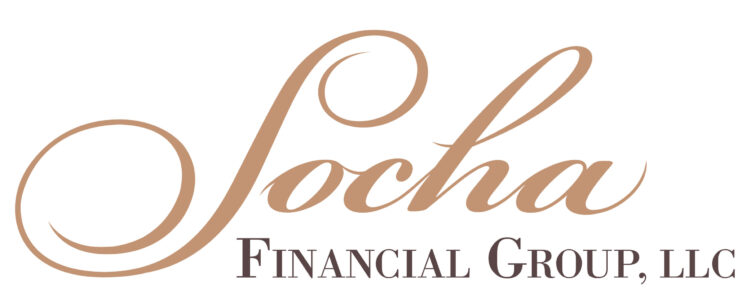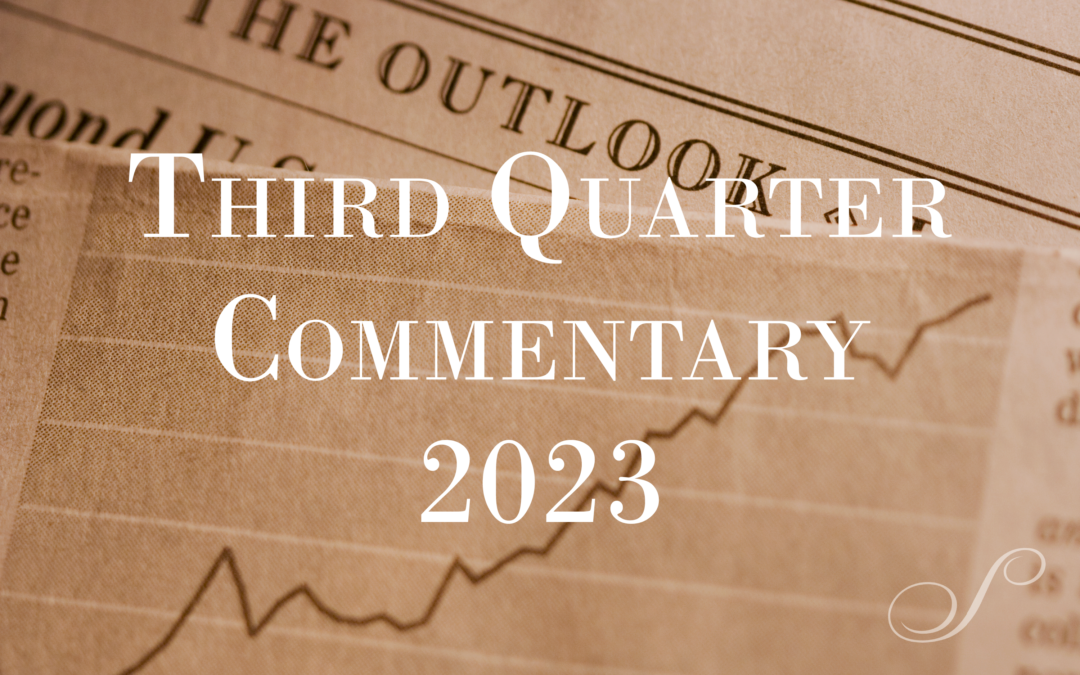At the beginning of the year, most economic forecasters predicted the US would be in or entering a recession by now. Instead, the US economy was very strong in the third quarter with the Atlanta FED GDPNow forecast estimating 4.9% real GDP growth. This strong growth has caused a spike in interest rates at the long end of the curve, with the 10-year and 30-year Treasury trading at levels not seen since 2007. The rise in rates weighed on stocks and bonds with the S&P 500 losing 6.3% and the Aggregate Bond Index losing 3.2% in the third quarter. The strong economy and tight labor market has complicated things for the Federal Reserve (FED) and there are growing concerns they will have to keep interest rates higher for longer. The FED raised rates at the July meeting but chose not to at the September meeting, while its forward guidance has left the door open for another hike in the future. Inflation fell to 3.2% in July before increasing to 3.7% in August, primarily driven by energy prices. Resiliency in the US economy, along with falling inflation, has increased optimism for a soft landing. However, with consumer and business spending likely to slow, recession remains a risk.
Nonfarm payroll gains have been steadily trending downward since the end of 2021. If this trend continues, it suggests payroll gains reach no growth in the second quarter of next year. Job openings have also been rapidly falling since they peaked at 12 million in March 2022 and hit a low of 8.8 million in July, only to surge back to 9.6 million in August due to a spike in professional services. September nonfarm payrolls rose 336,000, which was much higher than expected. The unemployment rate remained unchanged at 3.8% and average hourly earnings growth slowed. Job growth was particularly strong in sectors such as leisure, healthcare and government. Legal immigration has accelerated with 1 million people entering the country per year and prime working age Americans have been returning to the work force. This should, over time, help to improve the labor supply although there is still a large shortage to overcome.
The FED raised interest rates by .25% at the July FOMC meeting but held them steady in September. The market is pricing in a 50% chance of one more hike in either November or December, and this will be highly dependent on the CPI and jobs data that is released between now and then. We think the recent rise in yields and tightening of credit conditions decreases the probability of another hike. However, if the labor market remains as strong as indicated in the September jobs report, that may give them enough reason for one more hike. A strong economy with stable inflation is a good thing for everyday Americans. However, inflation remains above the FED’s 2% target and to get there the FED wants the economy to slow rather than strengthen, as it did in the third quarter, making their job more difficult. The bond market understands this and responded by recently selling off with yields at the longer end of the curve spiking. When the 10-year treasury was trading at .5% in the summer of 2020, we said we didn’t know if that was the bottom for yields but that the risk was to the upside and therefore, we were keeping our interest rate risk (duration) on the bond side of the portfolio low. Now we feel we’re in the opposite situation. We are unsure if we have seen peak interest rates, but we do believe rates have further to fall than rise from here making core fixed income look attractive for the first time in 15 years. The FED’s dot plot, which shows where the FOMC members see rates going in the future, predicts there will be two rate cuts in 2024 and five in 2025. If the economy slows without going into a recession and inflation comes down, they may be able to achieve that. However, if we look to the past, most FED rate hike cycles are too restrictive, causing the economy to go into a recession and then cuts happen faster than expected.
Inflation has been steadily declining from the June 2022 high, until the August report came in higher on the back of increased energy prices. The shelter component, which currently makes up over half the headline number, has peaked and is starting to come down. The rate of decline of inflation will likely slow but as the shelter component rolls over, we think it will drag inflation lower over the year ahead. While the labor market remains tight, the silver lining of the hot September jobs report, at least when it comes to inflation, was that average hourly earnings growth slowed.
The economy is likely to slow as higher interest rates and tighter credit conditions start to take hold. On the demand side the obvious risks to the consumer are higher interest rates, higher gas prices, higher credit usage, the resumption of student loan payments, and the spending down of excess COVID savings. Overall, businesses have held up quite well, but when debt servicing comes into play and they must refinance debt or issue new debt at higher interest rates, they may feel a headwind. On the supply side, we simply have a limited number of workers. The United Auto Workers Union (UAW) strike to date has not had a meaningful impact but depending on how long it goes on and how many employees it affects, it could have ripple effects impacting the labor market and inflation. Unrest in Washington always seems to be a risk, but a prolonged government shut down could have an impact.
Equities have performed well at the index level this year. The S&P 500 finished the quarter up 11.78% YTD but traded down 6.3% in the third quarter. Interestingly, the top ten stocks in the S&P 500 accounted for 97% of the gains. These were mostly the mega-cap technology companies that benefited from the speculation around artificial intelligence. Earnings held up better than expected and are on track to beat 2021 and 2022 levels. The consensus analysis estimates also forecast earnings improving in 2024 and 2025. At the start of the year, the common theme was that value stocks would outperform growth stocks- not only for the year, but for the rest of this economic cycle. Conversely, the Russell 1000 Growth index has outperformed the Russell 1000 Value index by 24% and the NASDAQ 100 (which makes up our core growth position) has outperformed the Russell 1000 Value index by 34.44%. We have remained roughly equal weight growth and value while continuing to focus on quality on the stock side of the portfolio. Maintaining our exposure to growth has worked well this year and we are happy with the current positioning in the portfolio.
In conclusion, the economy appears to have accelerated in the third quarter with estimates for real GDP growth between 4% and 5%. But in response to the strong economy, interest rates at the long end of the curve spiked, causing equities to sell off. While good news should be good news, the market fears that good news will cause the FED to keep rates higher for longer. Eventually, higher interest rates and a weakening consumer could slow the economy, making it more vulnerable to shocks. At the same time, earnings are predicted to improve and equities are fairly valued, which should be supportive of the market.
Happy Fall!
The Management Team
Michael, Michelle, Jolie and Nina
Important Disclosure Information
Please remember that past performance may not be indicative of future results. Different types of investments involve varying degrees of risk, and there can be no assurance that the future performance of any specific investment, investment strategy, or product (including the investments and/or investment strategies recommended or undertaken by Socha Financial Group, LLC (“SFG”), or any non-investment related content, made reference to directly or indirectly in this commentary will be profitable, equal any corresponding indicated historical performance level(s), be suitable for your portfolio or individual situation, or prove successful. Due to various factors, including changing market conditions and/or applicable laws, the content may no longer be reflective of current opinions or positions. Moreover, you should not assume that any discussion or information contained in this commentary serves as the receipt of, or as a substitute for, personalized investment advice from Socha. Please remember to contact Socha, in writing, if there are any changes in your personal/financial situation or investment objectives for the purpose of reviewing/evaluating/revising our previous recommendations and/or services, or if you would like to impose, add, or to modify any reasonable restrictions to our investment advisory services. Socha is neither a law firm, nor a certified public accounting firm, and no portion of the commentary content should be construed as legal or accounting advice. A copy of the SFG’s current written disclosure Brochure discussing our advisory services and fees continues to remain available upon request.
Historical performance results for investment indices, benchmarks, and/or categories have been provided for general informational/comparison purposes only, and generally do not reflect the deduction of transaction and/or custodial charges, the deduction of an investment management fee, nor the impact of taxes, the incurrence of which would have the effect of decreasing historical performance results. It should not be assumed that your Socha account holdings correspond directly to any comparative indices or categories. Please Also Note: (1) performance results do not reflect the impact of taxes; (2) comparative benchmarks/indices may be more or less volatile than your Socha accounts; and (3) a description of each comparative benchmark/index is available upon request.
Please Note: Limitations: Neither rankings and/or recognition by unaffiliated rating services, publications, media, or other organizations, nor the achievement of any designation or certification, should be construed by a client or prospective client as a guarantee that he/she will experience a certain level of results if Socha is engaged, or continues to be engaged, to provide investment advisory services. Rankings published by magazines, and others, generally base their selections exclusively on information prepared and/or submitted by the recognized adviser. Rankings are generally limited to participating advisers (see link as to participation data/criteria, to the extent applicable). Unless expressly indicated to the contrary, Socha did not pay a fee to be included on any such ranking. No ranking or recognition should be construed as a current or past endorsement of Socha by any of its clients. ANY QUESTIONS: SFG’s Chief Compliance Officer remains available to address any questions regarding rankings and/or recognitions, including the criteria used for any reflected ranking.

